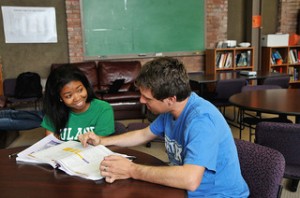School districts across the United States are spending millions of dollars on tutors to help economically and academically disadvantaged students outside of regular school hours. Large numbers of disabled students and those learning English receive such help. Significant funding comes from the federal government. The No Child Left Behind law that Congress passed in 2002 requires public schools whose students do not make adequate progress over three consecutive years, according to standards set by their state government, to offer extra academic assistance to children in low-income families, including private tutors. Almost half of all schools across the United States failed to make adequate progress in 2010-11—up from 20 percent of schools in 2006.
With the steady increase in students eligible for tutoring, parents and school districts need to know what works best—and the need for sound, research-based guidance is all the more pressing now that school districts in 41 states plus the District of Columbia and parts of California have been granted permission (“waivers”) from the U.S. Department of Education to use tutoring dollars more flexibly than in the past.
In a search for helpful answers, my research colleagues and I have done a groundbreaking study of tutoring practices and effectiveness in large urban public school districts. Our research was conducted over four years from 2009-10 to 2012-13 in six urban districts: Austin Independent School District, Chicago Public Schools, Dallas Independent School District, Los Angeles Unified School District, Milwaukee Public Schools, and Minneapolis Public Schools. We generated many kinds of evidence:- Quantitative estimates of the impact of total hours of tutoring on changes in math and reaching achievement scores—for more than 2.1 million students served by over 200 different tutorial services providers. Estimates were made for students overall, and for subgroups of students with special needs.
- Estimates of the effectiveness of various businesses and nonprofit organizations that provide tutoring services and assessments of different techniques—such as computerized methods or in-person meetings with students at school or elsewhere.
- Observations of 185 full tutoring sessions, and 235 in-depth interviews with front-line tutors and of administrators in tutoring services organizations, as well with district and state-level educators charged with supervising tutoring programs.
- Results from focus group discussions with 221 parents of students who were eligible to receive special educational services.
- Reviews of curriculum materials plus documents outlining federal, state, and school district policies about the special services we were investigating.
Key Findings about Effective Tutoring
Integrating all of this evidence, we were able to arrive at conclusions about the types of tutoring programs and service providers that have demonstrated the greatest effectiveness. Here are some of the most important findings:
- To have a measurable impact, students need to get at least 30 hours during the school year—and beyond that, there is a strong, positive relationship between the number of tutoring hours and improvements in student achievement.
- The most consistent positive effects happened in the Chicago Public Schools system, where students usually received 36 to 39 hours of tutoring on average during the school year from tutors who charged some of the lowest hourly rates we saw in our study (i.e., as low as $13 per hour).
- Parents, we found, often have incomplete or even misleading information about tutors’ qualifications or ability to make specially tailored efforts to address their children’s needs.
Beyond these overall findings, we discovered that tutoring was not very effective at increasing the achievement of up to one quarter of all tutored students who had disabilities or were learning English for the first time. This weak impact happened even though the English language learners got more hours of tutoring. We also found widespread confusion about who, exactly, is responsible for serving students with special needs. Specially trained tutors were rarely present, and staff people often did not get the data they needed to tailor services for disabled students.
Digital tutoring was another area we probed closely, because such tutoring programs are becoming increasingly common, despite costing more per hour than other kinds of tutoring. Digital offerings varied greatly in the districts we studied and were often poorly tailored to students’ individual needs. Tellingly, our data suggest that digital tutoring is twice as effective—especially at raising math scores—if students have face-to-face interaction with instructors, rather than proceeding entirely on their own via the Internet.

From Research to Practice
School districts that participated in our study are using the findings to change or improve tutoring services offered to students both during and after school. Milwaukee, Minneapolis, Chicago, and Dallas are all requiring tutoring providers to deliver more hours and are monitoring student participation and results. Several districts now require providers to give lessons more closely aligned to school curricula. And districts are increasingly sharing information about what works and what doesn’t. Along with careful research, such communication is vital to the rapid improvement of tutoring and other supplemental education services for students who may otherwise be left behind.
—
Read more in Carolyn J. Heinrich, Patricia Burch, Annalee Good, Rudy Acosta, Huiping Cheng, Marcus Dillender, Christi Krishbaum, Hiren Nisar, and Mary Stewart, “Improving the Implementation and Effectiveness of Out-of-School-Time Tutoring.” Journal of Policy Analysis and Management (online first article, January 2014).

 Research to Improve Policy: The Scholars Strategy Network seeks to improve public policy and strengthen democracy by organizing scholars working in America's colleges and universities. SSN's founding director is Theda Skocpol, Victor S. Thomas Professor of Government and Sociology at Harvard University.
Research to Improve Policy: The Scholars Strategy Network seeks to improve public policy and strengthen democracy by organizing scholars working in America's colleges and universities. SSN's founding director is Theda Skocpol, Victor S. Thomas Professor of Government and Sociology at Harvard University.